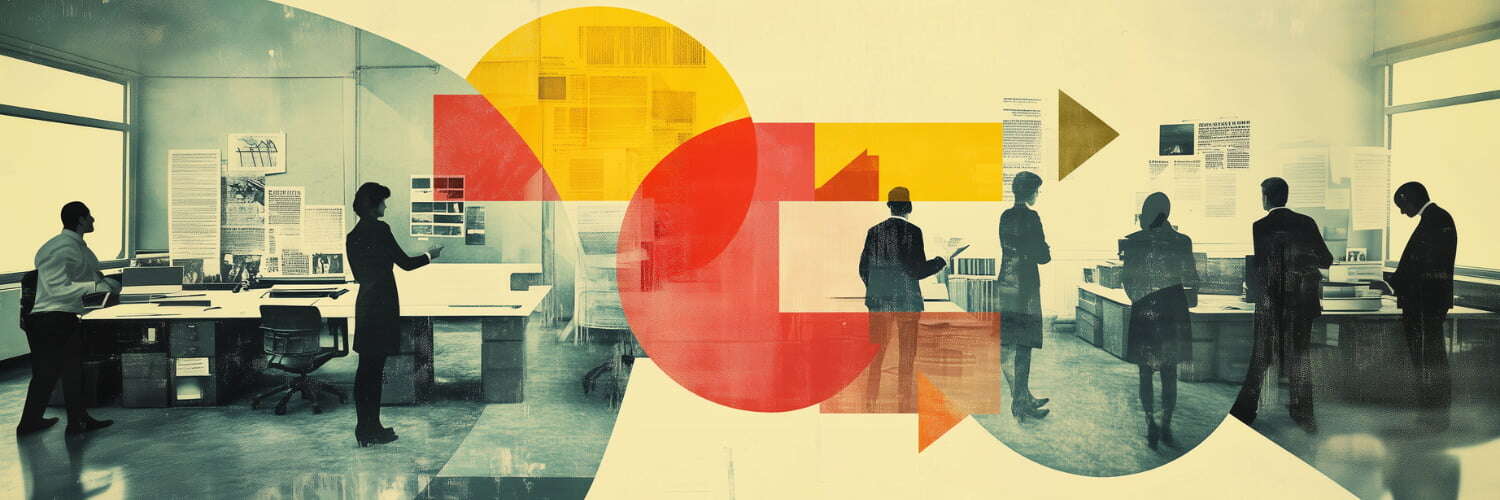Companies that survive and thrive in a corporate landscape as dynamic as a stormy sea embrace change with open arms. Change is no longer an option; it's a necessity, especially in human resources (HR)—a realm historically panned for its resistance to innovation. But piracy on the high seas wasn't abolished without trailblazing new routes, and, similarly, rigid HR policies won't give way without fresh winds of transformation.
Are you ready to set your compass towards the unwritten horizons of innovative HR?
TL;DR:
- HR is undergoing transformative changes, requiring innovative strategies for success.
- Innovation in HR involves creating and applying novel ideas and tools for enhanced employee management.
- HR transformation is driven by integrating cutting-edge technologies like AI and data analytics.
- HR leaders play a crucial role in fostering a culture of innovation and navigating ethical considerations.
- Fostering a culture of innovation requires creating a supportive environment, encouraging collaboration, and providing resources for skill development.
- HR leaders must have strategic thinking, change management skills, and a collaborative mindset to drive innovation.
- Metrics like employee engagement scores, turnover rates, and training completion rates are used to assess the impact of HR innovation.
- Ethical considerations include balancing privacy with AI use and ensuring fairness in recruitment algorithms.
- HR professionals need to stay updated on HR trends, develop skills in design thinking and agile methodologies, and navigate the benefits and challenges of HR innovation.
What is Innovation in HR?
Definition and Importance of HR Innovation
Innovation in HR refers to creating and applying novel ideas, strategies, and tools designed to enhance employee management and business efficiency. It's like discovering a treasure map where X marks the spot for increased productivity and a more engaged workforce.
Why is this sparkle-eyed voyage into uncharted waters essential? The importance of innovation within HR can't be understated—it's about becoming an alchemist who transforms base metals into gold. It means converting traditional processes into value-added systems tailored for today's fast-paced world. This evolution has profound implications for attracting top-tier talent, retaining employees, improving performance metrics, and ultimately nurturing a workplace that buzzes with creativity and engagement.

Role of Innovation in Driving HR Transformation
In the dynamic landscape of contemporary business, the role of innovation in driving HR transformation is pivotal. Innovation within human resources enhances traditional processes and catalyzes a paradigm shift in organizational culture and efficiency.
By integrating cutting-edge technologies, such as Artificial Intelligence (AI) and data analytics, HR professionals can streamline recruitment processes, identify talent more effectively, and optimize employee engagement. Moreover, innovation enables the development of agile and adaptive HR strategies, aligning workforce management with rapidly evolving business needs.
Embracing innovative solutions also empowers HR teams to enhance employee experience through personalized development programs, flexible work arrangements, and data-driven performance management.
Ultimately, by fostering a culture of innovation within HR, organizations can position themselves at the forefront of industry trends, attracting and retaining top talent while ensuring long-term success and competitiveness in the ever-changing business landscape.
Key Trends in HR Innovation
HR innovation is vital to any organization's growth and efficiency. As HR leaders strive to adapt to the rapidly changing work environment, embracing new technologies and methodologies becomes crucial. Below, we'll explore some of the salient trends that are shaping HR management.
Use of AI and Machine Learning in Recruitment and Selection
Artificial Intelligence and Machine Learning have revolutionized how companies attract, identify, and select top talent.
- Efficient Resume Screening: By automating the resume screening process, AI significantly reduces time-to-hire and helps recruiters focus on engaging with candidates rather than sifting through applications. However, for job seekers, it's good to remember focusing on quality over automation, making professional CVs from expert services a necessary consideration rather than relying on general AI helpers.
- Enhanced Candidate Matching: Machine learning algorithms can predict candidate suitability more accurately by analyzing complex datasets – something human recruiters might overlook.
- Bias Reduction: Properly programmed AI tools can minimize unconscious biases by making data-driven decisions focused on a candidate’s experience and competencies.
These innovative HR practices are streamlining processes and leading to more diverse workplaces by allowing qualified candidates from different backgrounds to emerge through an objective selection protocol.
Digital Onboarding and Employee Self-service Portals
The transition from being a candidate to becoming part of an organization is smoother, thanks to digital onboarding platforms. These portals offer:
- A singular place for completing paperwork digitally, which accelerates the onboarding process.
- Access to training materials at the fingertips of new hires, enabling them to start their self-learning journey immediately.
- Integration with other HR systems for seamless information flow across departments.
Employee self-service portals empower staff members by giving them direct access to manage personal data, benefits, leave requests, etc., fostering autonomy within the organizational structure.
Gamification in Training and Development
Implementing game mechanics into non-game environments like training and onboarding programs has proven beneficial. Gamified learning ensures higher engagement levels among employees as it combines fun with education. It offers:
- Interactive scenarios that promote problem-solving skills in real-world situations.
- Instant feedback encourages continuous improvement.
- Leaderboards that kindle healthy competition among peers.
Innovative HR approaches using gamification turn routine training into dynamic experiences that boost knowledge retention rates significantly.
Chatbots and Virtual Assistants for HR Support
Chatbots powered by Artificial Intelligence instantly respond to employee queries, day or night. This innovation in HR trend includes:
- Handling standard questions about company policies, pay slips, or holiday entitlements without human intervention.
- Simplifying administrative tasks by guiding users through processes such as booking annual leave or reporting sickness absences.
Virtual assistants bridge gaps between team members across various locations or time zones by delivering prompt support whenever needed.
Employee Wellness Tools and Programs
Focusing on mental health has led to innovative HR solutions for incorporating wellness tools into workplace culture.
- Platforms offering mindfulness exercises contribute positively toward stress reduction among employees.
- Fitness trackers encourage physical activity challenges, promoting overall well-being among teams.
Such initiatives resonate well with modern workforces that value employers invested in their holistic health.
Big Data Analytics for Talent Management
Big data analytics is transforming innovation and strategies around talent acquisition and retention. Predictive models can forecast turnover risks before they happen, allowing preemptive action plans. Furthermore:
- Performance metrics analyzed over time help customize career development paths based on individual strengths uncovered through data patterns.
- Insights drawn from analytics guide strategic workforce planning, efficiently aligning business objectives with future talent needs.
Integrating big data into talent management echoes a shift towards proactive rather than reactive HR processes rooted deeply in the intelligent interpretation of vast information clusters available today.
Exploring these key trends proves that HR innovation isn't simply about adopting new tools—it represents a fundamental shift in managing people with technology-powered foresight.
Workplace Experience Software
Workplace experience software, exemplified by platforms like YAROOMS, is at the forefront of HR innovation, reflecting a holistic approach to shaping a positive and efficient work environment.
These platforms offer comprehensive solutions, such as desk booking and meeting room booking, hybrid work planning, digital signage, and visitor management. HR professionals benefit from streamlined workspace management, customization of employee experiences, and data-driven insights into engagement and satisfaction.
Beyond HR, other departments gain advantages like optimized space utilization, workplace flexibility, and improved communication, fostering collaboration and productivity. Employees, in turn, experience enhanced satisfaction, increased workplace flexibility, and support for well-being initiatives.
The software's data-driven approach supports informed decision-making, promoting cost optimization and a positive workplace culture.
In summary, workplace experience software is a critical trend in HR innovation that aligns with the evolving needs of the workforce, offering benefits across HR, other departments, and employees, ultimately contributing to a dynamic and adaptive organizational culture.
How to Foster a Culture of Innovation in HR
Creating an atmosphere where innovation thrives takes time. As an HR leader, planting the seeds to allow innovative practices to flourish is crucial. Let's walk through some pivotal steps that can transform your organization into a hotbed for creative solutions.
Creating a Supportive Environment for Experimentation and Risk-Taking
Innovation can't bloom without fertile soil, which means developing a company culture that embraces trial and error. Employees must understand that not every initiative will lead to immediate success—and that's perfectly okay. Here's how you can cultivate this mindset:
- Empowerment over Permission: Encourage team members to act on their ideas rather than waiting for approval. This could mean setting up an 'innovation incubator' where they can work on projects beyond their day-to-day responsibilities.
- Fail Forward: Embrace setbacks as learning opportunities. While celebrating victories is essential, equally share lessons from projects that didn't pan out.
- Risk-Awareness Training: Equip your staff with the skills to assess and manage risks effectively to make informed decisions when experimenting.
Cultivating such an atmosphere requires diligence and patience, but laying down these principles will help innovative HR practices take root.
Encouraging Collaboration and Cross-Functional Teams
Siloed departments are often the death knell for human resources innovation because new ideas usually spring from diverse perspectives intersecting. So, toss collaboration at the center stage with these strategies:
- Facilitate Knowledge-Sharing Sessions: Organize regular meet-ups across different functional areas to discuss ongoing challenges and brainstorm solutions.
- Promote Cross-Departmental Projects: Assign team members from varying disciplines to tackle problems collectively; varied expertise often spells inventive resolutions.
- Make Room for Social Interaction: Water-cooler moments aren’t just about casual chit-chat; they’re breeding grounds for serendipitous idea exchanges.
Such initiatives introduce fresh angles and break down barriers, fostering trust—a cornerstone of any collaborative endeavor.
Providing Resources and Training for Innovation Skills Development
To sustainably innovate HR, you need more than spirit—skill. Equip your workforce with the necessary tools by investing in two key areas:
- Continuous Learning Opportunities: Offer courses, workshops, or subsidies for external classes focused on creativity, strategic thinking, and data analysis—whatever fuels innovation within your field.
- Tangible Tools Access: Whether it's software subscriptions or licenses for cutting-edge workplace analytics technologies or employee engagement platforms, ensure individuals have what they need at their fingertips.
When people feel supported by tangible skill-building resources alongside encouragement to question norms, you'll witness the emergence of innovative human resources practices like never before.
By adhering closely to these principles, human resource leaders ignite a powerful force marked by empowerment, agility, and tactical prowess that transforms "business as usual" into pioneering strides toward an innovative horizon.

The Future of HR Innovation: Emerging Trends and Technologies
The landscape of human resources is continuously transforming, integrating new technologies that redefine how we engage with employees and manage their data. Such advancements herald a future where the HR innovation practice is not simply about adopting cutting-edge tools but creating an ecosystem that enables perpetual growth and adaptability.
Virtual Reality and Augmented Reality in Employee Training
Immersive experiences provided by virtual reality (VR) and augmented reality (AR) are no longer confined to the realm of gaming; they're revolutionizing employee training programs:
- Realistic Simulations: VR allows trainees to practice their skills in life-like simulations without the risks associated with real-world training.
- Interactive Modules: AR overlays visual prompts or step-by-step instructions in natural work environments, enhancing practical learning.
- Engagement Boosters: These technologies turn mundane material into engaging experiences, ensuring higher retention rates and more impactful learning outcomes.
As innovations that excite both employers and staff, VR and AR offer scalable solutions for industries requiring complex skill sets or safety protocols—innovations that derive tangible benefits while also captivating those who use them.
Blockchain Technology for Secure Employee Data Management
In an era where data breaches are ever-present threats, blockchain emerges as a bastion for secure transactions:
- Immutable Records: By design, once entered into the blockchain ledger, it becomes nearly impossible to alter information unnoticed.
- Decentralization Efficiency: Reducing centralized points of failure minimizes cyber-attacks or data corruption risks.
- Enhanced Privacy Compliance: Built-in encryption methods make blockchain conducive for managing sensitive HR data in line with strict privacy regulations like GDPR.
HR departments can leverage blockchain technology to safeguard employee records and streamline processes such as payroll, benefits administration, or background checks—an innovative shift towards greater efficiency and security.
Predictive Analytics for Workforce Planning
Predictive analytics transforms how HR anticipates staffing needs, pinpoints potential issues before they erupt, and informs decisions using data-driven insights:
- Trend Analysis: Understanding past patterns helps forecast future workforce requirements more accurately.
- Risk Mitigation: Identifying high turnover risk areas allows preemptive strategy formulation to enhance retention.
- Strategic Talent Acquisition: Analyzing market trends supports proactive talent sourcing aligning with business objectives.
Harnessing predictive analytics signifies a considerable leap in 'proactive evolution' within HR practices—it's a culmination point where experience meets insight through state-of-the-art statistical techniques. It exemplifies an HR innovation practice fully attuned with aspirations toward strategic excellence.

The Role of HR Leaders in Driving Innovation
Human resources (HR) leaders are pivotal in steering an organization toward a more innovative horizon. Their influence spans fostering the right mindsets, enabling creative environments, and launching HR initiatives encouraging out-of-the-box thinking. In this transformative era, where change is the only constant, HR leaders must act as catalysts to embed innovation into the company's DNA.
Key Responsibilities of HR Leaders in Fostering a Culture of Innovation
As custodians of company culture, HR leaders are uniquely positioned to nurture environments ripe for innovation. Here are several fundamental responsibilities they hold:
- Vision Setting: They articulate a clear vision for what innovation looks like in their organization – its purpose, value, and how it will shape business outcomes.
- Strategy Integration: Integrating innovation into all examples of HR strategic initiatives ensures that every aspect of HR practices encourages inventive thought processes.
- Resource Allocation: Providing tools, time, and financial backing for employees to experiment with new ideas is essential. This includes creating dedicated innovation labs or hackathons.
- Cultural Change Leadership: By leading by example and embodying innovative behavior, HR leaders can inspire others within the organization.
- Recognition Systems: Establishing rewards and recognition systems that applaud risk-taking and not just successful outcomes helps promote a trial-and-error approach necessary for originality.
Emphasizing these key responsibilities cements an organization’s commitment toward progressive transformation – turning routine tasks into opportunities for improvement and growth.
Skills and Competencies Required for HR Leaders to Be Innovative
Fostering this much-needed culture isn't merely about setting directives; it requires distinct skills and competencies from those at the helm:
- Strategic Thinking: Innovative HR leaders need foresight to anticipate future talent needs and craft strategies that align with overarching business goals.
- Change Management: An adeptness in workplace change management is paramount as innovations often disrupt existing processes – requiring careful navigation through organizational restructures or workflow redesigns.
- Creative Problem-Solving: At the crux of innovation lies creative problem-solving abilities, allowing HR professionals to devise unconventional solutions to complex challenges.
- Tech Savviness: In an age brimming with technological breakthroughs influencing examples of HR initiatives from recruitment to employee engagement tactics - staying abreast with tech trends is non-negotiable.
- Collaborative Mindset: Encouraging teamwork across boundaries allows sharing of diverse insights that spur original ideas—it's all about leveraging collective intelligence.
Mastering these capabilities is instrumental—a testament to lending credence to their expertise in identifying areas primed for evolution.
Measuring the Impact of HR Innovation
Metrics and Indicators to Assess the Effectiveness of HR Innovation Initiatives
Measuring impact is as critical as implementing it when innovating within Human Resources. A well-structured metrics system highlights successes and sheds light on areas needing improvement. Let's delve into some tangible indicators.
- Employee Engagement Scores: Regularly surveying employees can garner insights into how innovation affects their day-to-day experiences and their level of engagement.
- Turnover Rates: Innovations aimed at retention should ideally result in lower turnover rates, a significant indicator of a thriving work environment.
- Time-to-Hire: The efficiency gains from innovative recruitment tools can be measured through reductions in time-to-hire.
- Training Completion Rates: Are employees progressing through development modules more quickly? This could indicate a practical implementation of gamified learning or e-training platforms.
Of course, these are just preliminary markers. Employee innovation examples might include staff autonomously piloting new projects or contributing ideas that lead to cost savings—tracking these occurrences quantifies internal entrepreneurial activity.
Using Feedback and Data Analysis to Continuously Improve HR Innovation Efforts
Feedback loops are indispensable when aiming for continuous improvement in HR processes. Here's where constructive criticism becomes a stepping stone rather than a stumbling block:
- Regular Feedback Surveys: Anonymous surveys enable employees to voice opinions candidly on what's working and what isn't with newly implemented innovations.
- Data Mining and Analytics: Parsing HR data with analytical tools can reveal patterns and correlations previously unnoticed, providing deeper insight for decision-making.
To capitalize on feedback without overwhelming the workforce with incessant questionnaires:
- Deploy focused pulse surveys after specific initiatives roll out.
- Create open channels where staff can submit examples of innovative ideas in the workplace anytime—an 'innovation box,' so to speak.
Finally, condensing complex data analysis results into digestible reports empowers all stakeholders—not just those in HR—to understand the direction and effectiveness of innovation efforts within your organization. Remember, the story behind the numbers matters as much as the metrics themselves; narrating this effectively will drive home the value of persistent innovation in human resources management.
Ethical Considerations in HR Innovation
Nurturing innovation within human resources isn't just about harnessing the latest technologies or implementing the newest methodologies. It also involves recognizing and navigating through an array of ethical considerations that ensure respect for individual rights, equity, and compliance with laws and regulations.
Balancing Privacy and Data Protection With the Use of AI and Analytics
The advent of artificial intelligence (AI) has granted HR professionals exciting new ways to process vast amounts of employee data efficiently. While these can forecast trends, tailor training programs, and enhance organizational productivity, they come with serious privacy implications. Striking a balance between leveraging data for legitimate business purposes and protecting employee privacy is crucial.
Here's how this delicate equilibrium can be achieved:
- Implement transparent policies: Clearly communicate what data is collected, why it’s necessary, and how it will be used.
- Strict access controls: Ensure that sensitive data is accessible only by authorized personnel.
- Regular audits: Conduct frequent checks to make sure data usage complies with all relevant laws and internal protocols.
- Anonymization techniques: When possible, anonymize data so that individuals cannot be directly identified from datasets.
These practices help secure trust among employees which is essential when introducing technological innovations within a company's culture.
Ensuring Fairness and Non-bias in Recruitment and Performance Evaluation Algorithms
AI-driven tools promise increased objectivity in recruitment and performance evaluations; however, they may inadvertently perpetuate biases if not carefully designed. Even algorithms learn from existing data, which might contain biased human decisions from the past. To mitigate this risk:
- Regularly review algorithmic assessments against diverse human perspectives to identify potential biases.
- Use multiple algorithms or models rather than relying on a singular system to avoid cementing systemic issues.
- Keep humans in the loop by having experts oversee AI-generated recommendations for hiring or evaluations—machines should assist rather than dictate final decisions.
- Promote diversity within teams creating these algorithms—as heterogeneous groups are more likely to account for various bias blindspots.
In conclusion, while AI brings efficiency gains to HR functions, moving forward responsibly means placing ethics at the forefront of any innovative endeavor. Only then can HR leaders modernize their domain without compromising on core principles that safeguard people's most fundamental workplace rights.

The Role of HR Professionals in Embracing and Leading Innovation
The fast-paced, ever-changing business landscape dictates a need for continual innovation. Human Resources (HR) professionals are at the forefront of cultivating this culture within organizations. However, embracing and leading innovation is not just about adopting new technologies or practices; it's about nurturing an environment where new ideas can flourish and positively impact the organizational trajectory.
Strategies for HR Professionals to Stay Updated on the Latest Trends in HR Innovation
Remaining current with ongoing developments in the innovative HR space is challenging but crucial. Here’s how HR professionals can ensure they stay ahead of the curve:
- Participate in Professional Networks: Engaging with industry peers through professional platforms like LinkedIn or attending webinars allows for sharing insights and experiences about emerging trends. Using a LinkedIn scraper can help gather relevant profile data to identify key professionals and stay informed about industry shifts.
- Continuous Learning Commitment: Enrolling in courses related to future HR technologies maintains a fresh perspective while upholding a commitment to lifelong learning.
- Curate a Rich Information Diet: Following respected thought leaders, subscribing to relevant publications, and leveraging professional association resources informs one about groundbreaking advancements.
Actively seeking new knowledge equips HR professionals to understand where the industry is headed, ensuring their strategies align with futuristic visions.
Developing Skills in Design Thinking, Agile Methodologies, and Change Management for Effective Innovation Implementation
For effective implementation of innovative strategies, skill development is non-negotiable. Specific competencies particularly stand out:
Design Thinking:
- Possessing empathy to understand employee needs.
- Applying creativity to problem-solving leads to human-centered solutions.
- Adopting iterative processes that refine ideas into practical applications.
Agile Methodologies:
- Acquiring flexibility to adapt quickly as project requirements evolve.
- Cultivating collaboration across departments for diverse inputs.
- Promoting transparent communication that validates progress.
Change Management:
- Building resilience against potential resistance to change by articulating clear vision and benefits.
- Nurturing strong leadership qualities is crucial for guiding teams through uncertainties.
By mastering these skills, HR professionals can introduce innovations and secure successful adoption within their organizations. This proactive mindset supports businesses amidst constant change while promoting a dynamic corporate culture that drives forward momentum.
In essence, staying informed on recent developments while developing essential skills prepares HR leaders to adapt and thrive amid rapid shifts, fostering spaces where ingenuity isn't just welcome—it's celebrated.
Benefits and Challenges of HR Innovation
The advent of innovation in the HR sector signifies a transformation that carries immense potency for organizational growth and agility. However, as is typical with shifts of this magnitude, they present benefits and challenges requiring diligent navigation.
Improved Efficiency and Productivity Through Automation
One undeniable advantage of HR innovation is the substantial enhancement in operational efficiency it can usher in, primarily through automation. Here's how automation catalyzes better performance:
- Eliminating Repetitive Tasks: Automating routine administrative duties allows HR professionals to focus on strategic roles offering higher value.
- Faster Processing Times: Recruitment processes like resume screening and scheduling interviews become expedited, accelerating time-to-hire metrics.
- Data Accuracy: Automation reduces human errors in data entry and management. This precision ensures more reliable analytics critical for decision-making.
As a result, companies often witness marked improvements not just in output but also in employee morale. When empowered by technology, HR teams can accomplish more with less – optimizing their potential while conserving resources.
Enhanced Employee Experience and Engagement
Beyond sheer productivity lies another consequential benefit: enriching employee experience and engagement. Innovative HR practices convey several implications that serve to bolster overall satisfaction within the workforce:
- Personalization: Tailoring training programs or career development paths through AI recommendations promotes individual growth.
- Accessibility: Employee self-service portals simplify interactions with HR services, fostering an on-demand support environment.
- Communication: Better tools enable clearer and quicker communication channels between employees and HR representatives.
These enhancements feed into one another; an engaged employee is typically productive, thus generating a virtuous cycle venerable for any organization's culture.
Potential Barriers to Implementation and Strategies for Overcoming Them
Yet, no ascent toward innovation dominance is without its hurdles—here lie some prevalent obstacles along with strategies to surmount them:
- Cultural Resistance: Often, human inertia hinders the adoption of new systems. To address this reluctance, educate your workforce on the tangible personal benefits these changes bring about.
- Cost Concerns: Innovations can come with upfront expenses, which might deter investment. Demonstrating long-term savings through case studies or pilots can persuade stakeholders of their fiscal prudence.
- Skill Gaps: New technologies may require skills the team does not possess. Invest early in continuous learning plans that cultivate necessary competencies among your staff.
Additionally, foster an environment where failure during experimentation isn’t seen as catastrophic but instead as a step towards eventual success—it’s imperative for nurturing an innovative spirit amongst employees.
By marrying careful planning with proactive change management techniques such as those outlined above, organizations can navigate the delicate equilibrium between leveraging cutting-edge advancements within HR and maintaining steady operational fortitude amidst transitionary periods.
Wrapping Up
In conclusion, HR is transforming with innovative strategies, leading organizations into 2024. The imperative for change is akin to navigating stormy seas, requiring a pioneering spirit. HR innovation involves applying novel ideas and tools reshaping traditional processes from AI-driven recruitment to gamified learning.
Workplace experience software streamlines workspace management, benefiting HR, other departments, and employees. Emerging technologies like VR, AR, blockchain, and predictive analytics redefine employee training, data security, and talent management.
HR leaders are crucial in driving this innovation, fostering a culture of creativity, and navigating ethical considerations. Benefits include improved efficiency, enhanced employee experiences, and proactive talent management, while challenges necessitate strategic approaches. Embracing design thinking and agile methodologies, HR professionals contribute to a dynamic corporate culture where innovation is celebrated, positioning organizations at the forefront of industry trends.












